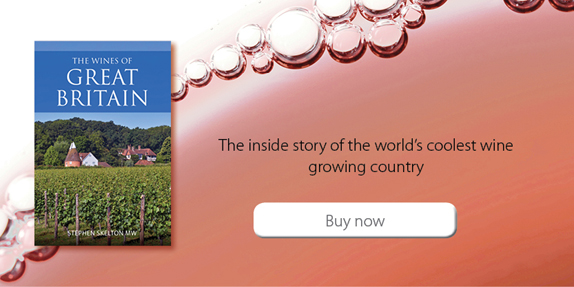Why Great Britain’s wines are fizzing with potential
8 May 2019 by Rebecca in Classic Wine Library, Wine and spirits
Most of us will be aware that the wines of England and Wales have come on in leaps and bounds since the beginning of this century. With brands like Chapel Down and Nyetimber becoming well known for their sparkling wines and English and Welsh wines taking up more shelf space in supermarkets such as Waitrose, even appearing on some pub menus, many of us will have had the chance to sample wines from these isles. So with Britain’s relationship with Europe in turmoil can lovers of French, Spanish and Italian wine start replacing their favourites with drinks from Kent, Cornwall and Yorkshire?
In his new book, The wines of Great Britain, English wine expert Stephen Skelton MW conducts a comprehensive study of the English and Welsh wine industries. Although much was done in the twentieth century towards the creation of a wine industry, the current wine growing phase dates back just 15–20 years and many contemporary producers are not much older than this. The good news is that despite their relative lack of experience, these businesses are already creating wines that can hold their own on the world stage. Some of the sparkling wines have even seen off competition from Champagne to win major wine awards. Several producers now make drinks that feature in the premium wine market and two Champagne houses have set up offshoots in Great Britain.
As a long-time consultant to the English wine industry Skelton is able to look behind these headlines. He notes that while there is much to celebrate, there is also considerable work to be done. Great Britain’s growers are still experimenting and learning when it comes to site selection and choice of rootstocks, the climate continues to pose challenges and producers have barely scratched the surface when it comes to developing the market beyond Britain’s shores. In years gone by the famous British weather often made for small harvests and poor fruit ripeness but if summers like that experienced in 2018 become more frequent, producers could find themselves faced with a problem of overabundance. As Skelton notes, “The exceptionally large harvest will strain the marketing skills of still wine producers and the bank balances of sparkling wine producers, who must find around £45,000–50,000 per hectare for picking, winemaking, bottling and storage of their wines. There are most definitely uncharted waters on the horizon.”
The 21 producer profiles showing how producers of all sizes are tackling these issues are fascinating. They illustrate a broad range of business approaches, as well as differences in field and winery, but above all demonstrate how energetic this community is. There is still a long road to travel before we can chuck out the Bordeaux, but Skelton is optimistic: “There are many reasons to think Britain’s wines could get better in the future. The next few decades will be interesting ones to watch.”
About the author
Stephen Skelton began his wine career in 1975. In 1977 he established Tenterden Vineyards in Kent (now the home of Chapel Down) where he made wine for 23 vintages. He was also winemaker at Lamberhurst Vineyards, then the UK’s largest wine producer, between 1988 and 1991. He became a Master of Wine in 2003. He has written and lectured widely on English wine and has published four guides to UK vineyards, the 2001 edition of which, The Wines of Britain and Ireland, won the André Simon award for Wine Book of the Year. Other publications include Viticulture, a primer on the subject for students, and Wine Growing in Great Britain, for growers.
The wines of Great Britain is published on 13 May 2019. Review copies are available from marketing@infideas.com

